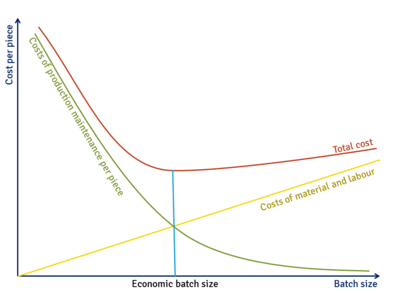Economic batch size: Difference between revisions
(Infobox update) |
mNo edit summary |
||
| Line 15: | Line 15: | ||
'''Economic batch size''' (economic order quantity) - is a [[method]] of inventory [[management]] in the supply chain. It assumes fixed quantity of each order of products whose amount is determined by the [[price]], the characteristics of [[demand]] and the [[cost]] of maintaining inventory and the [[cost]] of re-ordering. Using the EOQ in practice managers should also designate a point of reorder i.e. critical volume of stocks, which if reached, causes ordering od a certain size. The size of the order depends on the time required to receive the goods after placing the order, as well as on [[demand]]/volume of sales. | '''Economic batch size''' (economic order quantity) - is a [[method]] of inventory [[management]] in the supply chain. It assumes fixed quantity of each order of products whose amount is determined by the [[price]], the characteristics of [[demand]] and the [[cost]] of maintaining inventory and the [[cost]] of re-ordering. Using the EOQ in practice managers should also designate a point of reorder i.e. critical volume of stocks, which if reached, causes ordering od a certain size. The size of the order depends on the time required to receive the goods after placing the order, as well as on [[demand]]/volume of sales. | ||
[[File:Economic_batch_size.png|400px|right|thumb|Fig.1. Economic batch size]] | |||
The simple EOQ model assumes: | The simple EOQ model assumes: | ||
Revision as of 19:59, 1 September 2020
| Economic batch size |
|---|
| See also |
Economic batch size (economic order quantity) - is a method of inventory management in the supply chain. It assumes fixed quantity of each order of products whose amount is determined by the price, the characteristics of demand and the cost of maintaining inventory and the cost of re-ordering. Using the EOQ in practice managers should also designate a point of reorder i.e. critical volume of stocks, which if reached, causes ordering od a certain size. The size of the order depends on the time required to receive the goods after placing the order, as well as on demand/volume of sales.
The simple EOQ model assumes:
- continuous constant known amount of demand,
- full satisfying demand,
- constant, well-known cycle of replenishment, time of delivery,
- unlimited availability of capital,
- infinite planning horizon,
- no stock in transit,
- homogeneity of goods,
- fixed price or cost, which shall be independent of the size of the contract or time (purchase price, transport costs)
- R - Total volume of demand in the period (year or during the period)
- Q - The size of the order in units
- A - the cost of ordering
- V - cost per unit of inventory
- W - The percentage of maintenance costs of inventory in an annual inventory,
- S = V x W - the cost of inventory per unit per year (or test period)
- t - time in days
- TAC - total annual cost
The first part of the equation is the cost of maintaining inventory, the second refers to the cost of ordering. Optimal order quantity must minimize the costs per unit of the product. By differentiating the equation designating the total cost after Q and equating to zero, we get the following equation:
- or
Solving the above equation, we get the optimal order size.
See also:
References
- Eilon, S. (1959). Economic batch-size determination for multi-product scheduling. OR, 217-227.
- Jamal, A. M. M., Sarker, B. R., & Mondal, S. (2004). Optimal manufacturing batch size with rework process at a single-stage production system. Computers & Industrial Engineering, 47(1), 77-89.



